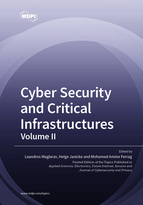Topic Menu
► Topic MenuTopic Editors



Cyber Security and Critical Infrastructures

A printed edition is available here.
Topic Information
Dear Colleagues,
Critical infrastructures are vital assets for public safety, economic welfare, and the national security of countries. Vulnerabilities of critical infrastructures have increased with the widespread use of information technologies. As Critical national infrastructures are becoming more vulnerable to cyberattacks, their protection becomes a significant issue for any organization as well as nation. The risks to continued operations from failing to upgrade aging infrastructure or not meeting mandated regulatory regimes are considered higher given the demonstrable impact of such circumstances.
Due to the rapid increase in sophisticated cyber threats targeting critical infrastructures with significant destructive effects, the cyber security of critical infrastructures has become an agenda item for academics, practitioners, and policy makers. A holistic view which covers technical, policy, human, and behavioral aspects is essential to handle the cyber security of critical infrastructures effectively. Moreover, the ability to attribute crimes to criminals is a vital element of avoiding impunity in cyberspace. Moreover, the coronavirus pandemic has created new challenges for businesses as they adapt to an operating model in which working from home has become the ‘new normal’. Companies are accelerating their digital transformation, and cybersecurity is now a major concern.
The aim of this Topic is to gather both research and practical aspects of cyber security considerations in critical infrastructures. Aligned with the interdisciplinary nature of cyber security, authors from academia, government, and industry are welcome to contribute.
We seek original and high-quality submissions on, but not limited to, one or more of the following topics:
• Security of supervisory control and data acquisition (SCADA) systems;
• Cyber security of complex and distributed critical infrastructures;
• Cyber security of industrial control systems;
•Cyber security modeling and simulation;
• Cyber threat modeling and analysis;
• Safety–security interactions;
• Cyber security engineering;
• Behavioral modeling;
• Network security and protocols;
• Security, privacy, and legal issues of big data and the Internet of Things;
• Cyber threat intelligence;
• Situational awareness;
• Attack modeling, prevention, mitigation, and defense;
• Cyberphysical systems security approaches and algorithms;
• Critical infrastructure security policies, standards, and regulations;
• Vulnerability and risk assessment methodologies for distributed critical infrastructures;
• Risk management and cyber insurance;
• Simulation and test beds for the security evaluation of critical infrastructures;
• Resiliency and security of cyber systems;
• Cyber security and privacy policies;
• Hardware security solutions;
• Incident response;
• Encryption, authentication, availability assurance;
• Human awareness and training;
• Intrusion detection;
• Trust and privacy preservation;
• Secure communication protocols;
• Malware analysis;
• Attribution of cyberattacks;
• Cyber warfare, peacekeeping;
• Hybrid war;
• Blockchain technology;
• Supply chain security;
• Ransomware.
Prof. Dr. Leandros Maglaras
Prof. Dr. Helge Janicke
Dr. Mohamed Amine Ferrag
Topic Editors
Keywords
- cybersecurity
- critical infrastructures
- privacy preservation
- risk management
- big data
- Internet of Things
- blockchain
- cyber threats
- cyber security and privacy policy
- hybrid war
- cybercrime
- smart grids
- cyber security modeling and simulation
Participating Journals
| Journal Name | Impact Factor | CiteScore | Launched Year | First Decision (median) | APC |
|---|---|---|---|---|---|

Applied Sciences
|
2.7 | 4.5 | 2011 | 16.9 Days | CHF 2400 |

Electronics
|
2.9 | 4.7 | 2012 | 15.6 Days | CHF 2400 |

Future Internet
|
3.4 | 6.7 | 2009 | 11.8 Days | CHF 1600 |

Sensors
|
3.9 | 6.8 | 2001 | 17 Days | CHF 2600 |

Journal of Cybersecurity and Privacy
|
- | - | 2021 | 23.5 Days | CHF 1000 |

MDPI Topics is cooperating with Preprints.org and has built a direct connection between MDPI journals and Preprints.org. Authors are encouraged to enjoy the benefits by posting a preprint at Preprints.org prior to publication:
- Immediately share your ideas ahead of publication and establish your research priority;
- Protect your idea from being stolen with this time-stamped preprint article;
- Enhance the exposure and impact of your research;
- Receive feedback from your peers in advance;
- Have it indexed in Web of Science (Preprint Citation Index), Google Scholar, Crossref, SHARE, PrePubMed, Scilit and Europe PMC.

